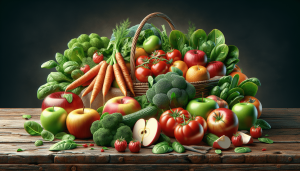Our journey into the world of organic food starts with understanding the core standards that govern it. In “Understanding the Standards for Organic Food,” we delve into the intricate guidelines that define what makes food truly organic. These standards cover everything from soil quality and animal raising practices to the absence of synthetic additives and pesticides. Join us as we explore these essential criteria, ensuring that we all make informed choices about the food we bring to our tables. Have you ever wondered what makes organic food truly organic? In our quest to live healthier and more sustainable lives, understanding the standards for organic food is essential. Let’s dive into this fascinating topic together and break down the key aspects that make food eligible for the coveted organic label.

What Are Organic Foods?
Organic foods are produced using farming practices that prioritize environmental health, animal welfare, and the well-being of farmers and consumers. Unlike conventional farming methods that often rely on synthetic chemicals and genetically modified organisms (GMOs), organic farming emphasizes naturally derived inputs and techniques. This means growing food without using chemical pesticides, synthetic fertilizers, sewage sludge, irradiation, or GMOs.
Organic Farming Practices
Organic farming involves various sustainable practices. These range from crop rotation and green manure to composting and biological pest control. Crop rotation helps maintain soil health and prevent pest infestations, while green manure enriches the soil with nutrients. Composting recycles organic waste back into the soil, and biological pest control uses natural predators to manage pests.
Animal Welfare in Organic Farming
Organic animal farming focuses on providing animals with a natural and humane living environment. This involves giving animals access to the outdoors, feeding them organically grown feed, and abstaining from the use of antibiotics and growth hormones. The objective is to ensure the animals’ well-being throughout their lives.
Regulatory Bodies and Certification
To ensure that food labeled as organic meets specific standards, regulatory bodies and certification processes are in place. These organizations enforce strict guidelines and perform inspections to maintain organic integrity.
United States Department of Agriculture (USDA)
In the United States, the USDA oversees the National Organic Program (NOP). This program establishes the standards for organic farming and the certification process. The USDA Organic seal is a widely recognized symbol indicating that a product meets the national organic standards.
European Union Organic Certification
In Europe, organic farming is regulated by the European Union. The EU’s organic logo indicates that a product complies with EU organic farming regulations. These standards are similar to those in the US but may have additional requirements, such as specific animal welfare mandates.
International Standards
Different countries have their own regulations for organic farming, often harmonized through international agreements. For example, the International Federation of Organic Agriculture Movements (IFOAM) works to create a cohesive global standard for organic agriculture.
Organic Crop Production Standards
Growing organic crops is governed by strict guidelines that emphasize soil health, biodiversity, and sustainable practices. Let’s delve into the various aspects involved in organic crop production.
Soil Management
Maintaining healthy, fertile soil is a cornerstone of organic farming. Farmers use organic matter, such as compost or animal manure, to enrich the soil. They also employ techniques like crop rotation and cover cropping to maintain soil fertility and structure.
Table: Soil Management Techniques
| Technique | Description |
|---|---|
| Crop Rotation | Changing the type of crop grown in each field every season to prevent pests and diseases and to maintain soil fertility. |
| Green Manure | Growing specific plants to enrich soil with nutrients when plowed under. |
| Composting | Recycling organic waste into nutrient-rich compost to improve soil fertility. |
| Cover Cropping | Planting cover crops to prevent soil erosion and enhance soil structure. |
Pest and Weed Control
Organic farming avoids synthetic pesticides and herbicides, relying instead on natural methods to control pests and weeds. This includes encouraging natural predators, using traps, and implementing mechanical weeding techniques.
Table: Pest and Weed Control Methods
| Method | Description |
|---|---|
| Biological Pest Control | Using natural predators or parasites to control pest populations. |
| Mechanical Weeding | Physically removing weeds using tools or machinery. |
| Trap Cropping | Planting crops that attract pests away from the main crop. |
| Mulching | Using organic mulch to suppress weed growth and retain soil moisture. |
Crop Diversity
Promoting biodiversity is a key principle of organic farming. Farmers grow a variety of crops to enhance soil health, reduce pest and disease risk, and provide habitat for beneficial organisms.
Organic Livestock Production Standards
Organic livestock production focuses on humane treatment and sustainable practices. Let’s explore the various standards that ensure the ethical treatment of animals in organic farming.
Living Conditions
Organic standards require that animals have access to the outdoors and sufficient space to exhibit natural behaviors. This means providing pasture for grazing and adequate shelter.
Table: Livestock Living Conditions
| Requirement | Description |
|---|---|
| Outdoor Access | Animals must have regular access to the outdoors. |
| Space | Sufficient space must be provided for animals to move freely and express natural behaviors. |
| Shelter | Adequate shelter should protect animals from harsh weather conditions. |
Feed and Nutrition
Animals on organic farms are fed organic feed, free of pesticides, GMOs, and animal by-products. The goal is to provide a balanced and natural diet, leading to healthier animals and higher-quality products.
Health Care
Preventive health care is a priority in organic livestock farming. This includes the use of natural remedies and practices to prevent disease, relying on antibiotics only as a last resort.
Table: Health Care Practices
| Practice | Description |
|---|---|
| Preventive Care | Focus on preventing disease through good management and natural remedies. |
| Restricted Antibiotic Use | Antibiotics may be used only when necessary, and withdrawal periods are enforced before products can be labeled organic. |

Organic Food Processing Standards
Once harvested, organic products must be processed in ways that preserve their organic integrity. This involves strict regulations on ingredient sourcing, processing methods, and handling procedures.
Certified Organic Ingredients
All ingredients in organic products must themselves be certified organic. This includes avoiding synthetic additives, preservatives, and artificial colors.
Processing Methods
Organic processing methods aim to maintain the natural quality of the ingredients. This means minimal processing and the use of natural techniques, avoiding chemical treatments and artificial preservatives.
Labeling Requirements
Clear labeling helps consumers identify genuinely organic products. The USDA Organic seal, for example, indicates that a product is made with at least 95% organic ingredients. Products with 70-94% organic content can be labeled as “made with organic ingredients.”
Table: Organic Labeling Categories
| Label Category | Description |
|---|---|
| 100% Organic | Products made entirely with organic ingredients. |
| Organic | Products containing at least 95% organic ingredients. |
| Made with Organic | Products containing 70-94% organic ingredients, with specific organic ingredients highlighted. |
Benefits of Organic Food
Understanding the standards for organic food also means appreciating the numerous benefits it offers. Let’s explore how organic farming positively impacts our health, the environment, and the economy.
Health Benefits
Organic foods are often richer in nutrients and free from harmful chemicals. Studies have shown they may contain higher levels of antioxidants, vitamins, and minerals compared to conventionally grown foods.
Environmental Benefits
Organic farming practices contribute to healthier ecosystems. By reducing chemical use and promoting biodiversity, organic farming helps conserve soil, water, and wildlife.
Economic Benefits
Supporting organic farming can boost local economies. Organic farms often employ more labor-intensive practices, creating more jobs. Additionally, organic farming can lead to better economic returns for farmers due to premium pricing for organic products.

Challenges and Misconceptions
While the benefits of organic food are clear, there are also challenges and misconceptions surrounding organic farming and labeling.
Cost of Organic Food
Organic products often come with a higher price tag, which can be a barrier for consumers. The increased cost is due to labor-intensive practices, certification fees, and lower crop yields. However, many argue that the long-term health and environmental benefits outweigh the initial expense.
Misconceptions About Organic Food
There are several misconceptions about organic food. Some believe that organic and natural are the same, but natural foods are not necessarily organic. Others think that organic foods last longer or taste better, which can vary depending on the product.
The Future of Organic Food
The future of organic food is promising, with increasing consumer demand and greater awareness of its benefits. However, the industry must navigate challenges such as scalability, accessibility, and certification complexities.
Technological Innovations
Advances in technology can help make organic farming more efficient and scalable. Innovations in pest control, irrigation, and soil management can enhance productivity while adhering to organic principles.
Policy and Regulation
Continued support from policymakers is essential to promote organic farming. This includes subsidies, research funding, and stricter regulations on organic labeling to maintain consumer trust.
Global Trends
The global organic food market is growing, driven by rising health consciousness and environmental concerns. This trend is expected to continue, with more countries adopting organic standards and certification processes.

Conclusion: Embracing Organic Standards
Understanding the standards for organic food helps us make informed choices that benefit our health, the environment, and society. By supporting organic farming practices, we contribute to a more sustainable and ethical food system. Let’s continue to learn, share, and grow our appreciation for the organic movement.
In sum, the journey to organic food is paved with rigorous standards, hard work, and a commitment to doing what’s right for our planet and our bodies. Embracing these principles can lead to a more vibrant, healthy, and sustainable future for us all.



